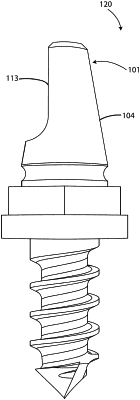| CPC A61B 34/20 (2016.02) [A61B 6/505 (2013.01); A61B 2034/2055 (2016.02)] | 11 Claims |

|
1. A system for registering at least a portion of a patient's spinal curvature and/or flexibility, comprising:
an acquisition system for acquiring data using a continuous or discrete 3D-tracked acquisition along a surface of a spine of the patient;
non-transient computer readable media for storing at least a portion of the acquired data;
one or more computer processors configured to analyze at least a portion of the acquired data and generating a quantitative assessment of the patient's spinal biomechanical qualities,
wherein the acquisition system includes a fiducial marker device with a registration interface and bone fixation features, wherein the registration interface includes a tapered cylindrical protrusion with a back surface and a keyed front surface used for mating with a 3-D tracked probe, wherein the registration interface is configured to be received inside a tip of the 3-D tracked probe during registration,
wherein the 3-D tracked probe registers continuous points along a surface of the spine of the patient,
wherein the 3-D tracked probe includes a depressible trigger button to enable an active state for registering points on the surface of the spine.
|